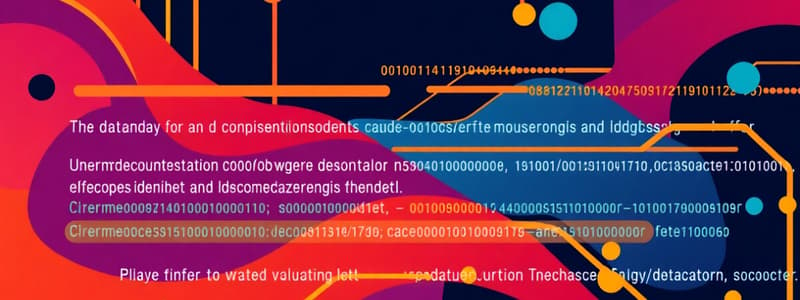Podcast
Questions and Answers
Which of the following best describes metadata?
Which of the following best describes metadata?
- Raw, unorganized facts that need processing.
- Data that describes the properties and context of user data. (correct)
- Data that has been processed to increase a person's knowledge.
- A structured representation of meaningful objects and events.
In the context of databases, what is the primary purpose of 'context'?
In the context of databases, what is the primary purpose of 'context'?
- To store representations of meaningful objects and events.
- To increase the amount of data available to users.
- To organize collections of logically related data.
- To help users understand the data by providing additional information. (correct)
Which of the following scenarios best illustrates the problem of program-data dependence in file processing systems?
Which of the following scenarios best illustrates the problem of program-data dependence in file processing systems?
- A company uses different systems for customer information, leading to data duplication.
- A company's new tax laws require frequent modifications to the payroll programs.
- A company modifies the length of the address field in a customer file, requiring changes to all programs that access the file. (correct)
- A small business uses a database management system to manage their inventory.
What is a key disadvantage of data redundancy in file-based systems?
What is a key disadvantage of data redundancy in file-based systems?
How does a database management system (DBMS) improve data sharing compared to file-based systems?
How does a database management system (DBMS) improve data sharing compared to file-based systems?
Which of the following is a key advantage of the database approach compared to file processing?
Which of the following is a key advantage of the database approach compared to file processing?
What is the role of a controlling agent in the database approach?
What is the role of a controlling agent in the database approach?
In database design, what does an entity represent?
In database design, what does an entity represent?
What is an attribute in the context of database entities?
What is an attribute in the context of database entities?
In database relationships, what does a one-to-many relationship signify?
In database relationships, what does a one-to-many relationship signify?
Which database component is responsible for managing the database?
Which database component is responsible for managing the database?
Which of the following best describes the function of data modeling and design tools in a database environment?
Which of the following best describes the function of data modeling and design tools in a database environment?
What is the primary purpose of the planning phase in the System Development Life Cycle (SDLC) for database development?
What is the primary purpose of the planning phase in the System Development Life Cycle (SDLC) for database development?
In the context of database schema, what does the conceptual schema represent?
In the context of database schema, what does the conceptual schema represent?
Which of the following tasks is typically performed during the database maintenance phase?
Which of the following tasks is typically performed during the database maintenance phase?
Flashcards
Database
Database
An organized collection of logically related data.
Data
Data
Stored representations of meaningful objects and events.
Information
Information
Data processed to increase the user's knowledge.
Metadata
Metadata
Signup and view all the flashcards
Program-Data Dependence
Program-Data Dependence
Signup and view all the flashcards
Duplication of Data
Duplication of Data
Signup and view all the flashcards
Data Inconsistency
Data Inconsistency
Signup and view all the flashcards
Database Management System (DBMS)
Database Management System (DBMS)
Signup and view all the flashcards
Enterprise Data Model
Enterprise Data Model
Signup and view all the flashcards
Entity
Entity
Signup and view all the flashcards
Attribute
Attribute
Signup and view all the flashcards
Relationship
Relationship
Signup and view all the flashcards
Relational Databases
Relational Databases
Signup and view all the flashcards
Data Modeling and Design Tools
Data Modeling and Design Tools
Signup and view all the flashcards
Repository
Repository
Signup and view all the flashcards
Study Notes
- Covers the fundamentals of database systems, including basic concepts, metadata, file processing disadvantages, data dependency/redundancy issues, and database approach advantages/disadvantages.
- Learning outcomes include understanding database concepts, metadata, constraints, file processing problems, database approaches, and their elements, advantages, along with costs and risks.
Basic Concepts of Database
- A database is an organized collection of logically related data.
- Data are stored representations of meaningful objects and events, which can be structured (numbers, text, dates) or unstructured (images, video, documents).
- Information is data processed to enhance the user's knowledge.
- Metadata describes the properties and context of user data.
- Context helps users interpret data.
Metadata and Constraints
- Metadata describes the properties or characteristics of data, including data types, field sizes, allowable values, and data context.
- Metadata includes properties that are typically described, such as data names, definitions, and length, as well as allowable values.
- Metadata describes the data context, including the source, storage location, ownership, and usage of the data.
Disadvantages of File Processing
- Program-data dependence means all programs maintain metadata for each file they use.
- Duplication of data occurs when different systems/programs have separate copies of the same data.
- Limited data sharing is due to no centralized control of data.
- Lengthy development times occur because programmers must design their own file formats.
- Excessive program maintenance can take up 80% of the information systems budget.
Problems with Data Dependency and Data Redundancy
- With data dependency, each application programmer has to maintain its own data and each application program needs to include code for the metadata as well as processing routines.
- Lack of coordination and central control and use of non-standard file formats are issues with data dependency.
- Data redundancy leads to wasted space and increased maintenance.
- Data inconsistency leads to integrity compromises.
The Database Approach
- Shared data has a central repository.
- Data is managed by a controlling agent
- Data is stored in a standardized, convenient form.
Database Management System
- A software system used to create, maintain, and provide controlled access to user databases.
- DBMS is a set of software tools that controls access, organize, store, manage, retrieve, and maintain data in a database.
Advantages of Database Approach
- It includes program-data independence, planned data redundancy, and improved data consistency.
- It has improved data sharing, increased application development productivity, and enforcement of standards.
- Improved data quality, improved data accessibility/responsiveness, reduced program maintenance, and improved decision support are also included.
Costs and Risks of Database Approach
- New, specialized personnel are required along with installation and management costs and complexity.
- There are conversion costs along with a need for explicit backup and recovery.
- There can be organizational conflict on data definitions, formats, coding, and rights to update.
Elements of Database Approach
- Data models are graphical systems capturing the nature and relationship of data.
- Entities are data models.
- There are relationships and relational databases.
Enterprise Data Model
- High-level entities and relationships for the organization.
Project Data Model
- Detailed view, matching data structure in database or data warehouse.
- Examples of entities with attributes included customer, order, order line, and products.
- Noun form describing a person, place, object, event, or concept.
- An attribute is a characteristic that describes that entity.
- There are one-to-one, one-to-many, many-to-one and many-to-many relationships.
Relational Databases
- Involve database technology.
- It has tables (relations) representing entities.
- Primary/foreign keys representing relationships.
Components of Database Environment
- Data modeling and design tools are automated tools used to design databases and application programs.
- A repository - centralized storehouse of metadata.
- The (DBMS) Database Management System software for managing the database.
- A database is a storehouse of the data.
- There are Application Programs-software using the data.
- Included text, graphical displays, menus, etc. for user.
- Data/Database Administrators-personnel are responsible for maintaining the database.
- System Developers-personnel responsible for designing databases and software.
- End Users people who use the applications and databases.
Enterprise Data Model details
- the first step in the database development process.
- Specifying scope and general content.
- Overall picture of organizational data at high level of abstraction:
- Entity relationship diagram (ERD).
System Development Life Cycle
- Has a Waterfall approach. Each output from one phase will flow to the next phase.
- Composed of Planning, Analysis, Logical Design, Physical Design, Implementation and Maintenance.
Prototyping Database Methodology
- A classical Rapid Application Development (RAD) approach.
- One of the most popular RAD methods is prototyping, which is an iterative process of systems development in which requirements are converted to a working system.
Database Schema
- External schema differ based on the view and User.
- The conceptual schema is the view of the data architect and data administrator.
- The internal schema is the underlying design and implementation.
Managing Projects: People Involved
- People involved include Business analysts, Systems analysts, Database analysts and data modelers, Users, Programmers, Database architects, Data administrators, Project managers and Other technical experts.
Range of Database Applications
- Applications can be Personal databases, Two-tier and N-tier Client/Server databases or Enterprise applications,
- Enterprise applications can implement enterprise resource planning (ERP) systems or data warehousing.
Studying That Suits You
Use AI to generate personalized quizzes and flashcards to suit your learning preferences.




